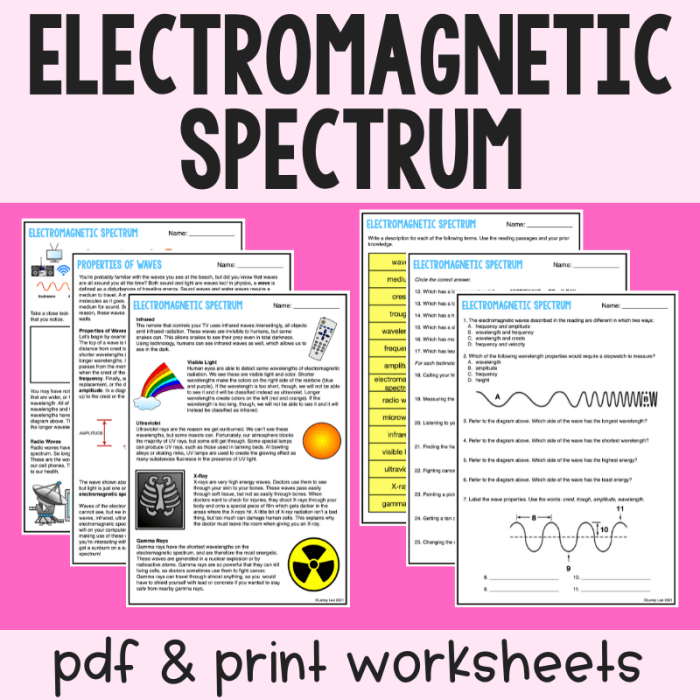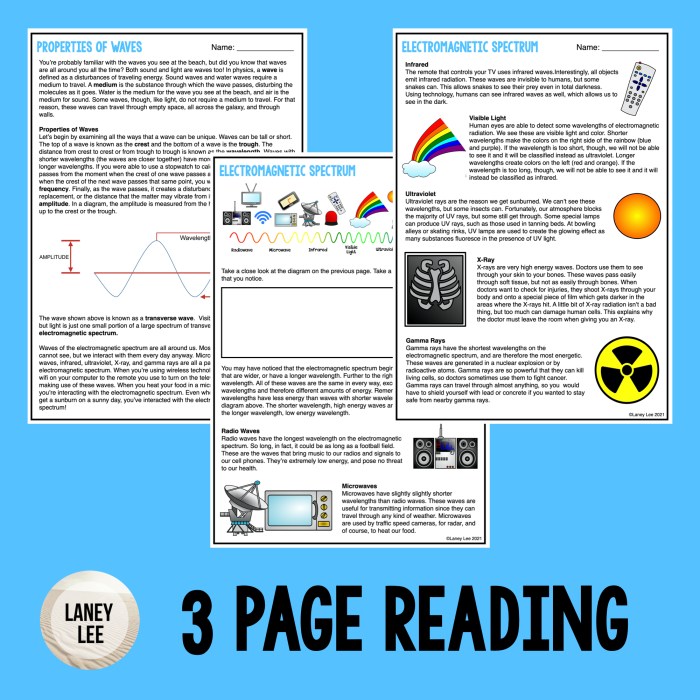The tour of the electromagnetic spectrum webquest answer key provides a comprehensive guide to understanding the properties, applications, and significance of the electromagnetic spectrum. This key unlocks a deeper understanding of the fundamental principles that govern the behavior of electromagnetic waves, enabling students to explore the vast array of applications across various scientific disciplines.
The electromagnetic spectrum encompasses a wide range of frequencies and wavelengths, including radio waves, microwaves, infrared radiation, visible light, ultraviolet radiation, X-rays, and gamma rays. Each type of electromagnetic wave possesses unique characteristics and interacts with matter in distinct ways, leading to a multitude of practical applications.
Introduction

The electromagnetic spectrum is a continuum of all possible frequencies of electromagnetic radiation. It encompasses a wide range of wavelengths, from very short gamma rays to very long radio waves. The electromagnetic spectrum is important because it allows us to understand the behavior of light and other forms of electromagnetic radiation.
It also has many applications in various fields, such as communication, medicine, and astronomy.
Properties of the Electromagnetic Spectrum: Tour Of The Electromagnetic Spectrum Webquest Answer Key
Types of Electromagnetic Waves
- Gamma rays
- X-rays
- Ultraviolet radiation
- Visible light
- Infrared radiation
- Microwaves
- Radio waves
Relationships between Frequency, Wavelength, and Energy
The frequency, wavelength, and energy of an electromagnetic wave are related by the following equation: E = hf, where E is energy, h is Planck’s constant, and f is frequency. The higher the frequency, the shorter the wavelength and the higher the energy.
Effects of Electromagnetic Waves on Matter
Electromagnetic waves can interact with matter in a variety of ways. They can be absorbed, reflected, transmitted, or scattered. The way in which an electromagnetic wave interacts with matter depends on the frequency of the wave and the properties of the material.
Applications of the Electromagnetic Spectrum
Communication, Tour of the electromagnetic spectrum webquest answer key
Electromagnetic waves are used to transmit information over long distances. This is the basis of radio, television, and cell phone communication.
Medicine
Electromagnetic waves are used in a variety of medical applications, such as X-rays, MRI scans, and cancer treatment.
Astronomy
Electromagnetic waves are used to study the universe. Telescopes detect electromagnetic waves from stars, planets, and other celestial objects.
Electromagnetic Spectrum Webquest

Links to Relevant Websites and Resources
- Britannica Encyclopedia: Electromagnetic Spectrum
- Khan Academy: Electromagnetic Spectrum
- PhET Interactive Simulations: Wave on a String
Discussion Questions
- What are the different types of electromagnetic waves?
- How are frequency, wavelength, and energy related?
- What are some of the applications of electromagnetic waves?
- How can we use electromagnetic waves to study the universe?
Helpful Answers
What is the purpose of the electromagnetic spectrum?
The electromagnetic spectrum serves as a fundamental tool for understanding the properties and behavior of electromagnetic waves, which are essential for a wide range of applications in science and technology.
How are electromagnetic waves used in various fields?
Electromagnetic waves find applications in diverse fields such as communication (radio waves, microwaves), medical imaging (X-rays, MRI), astronomy (infrared, ultraviolet, X-rays), and energy production (microwaves).
